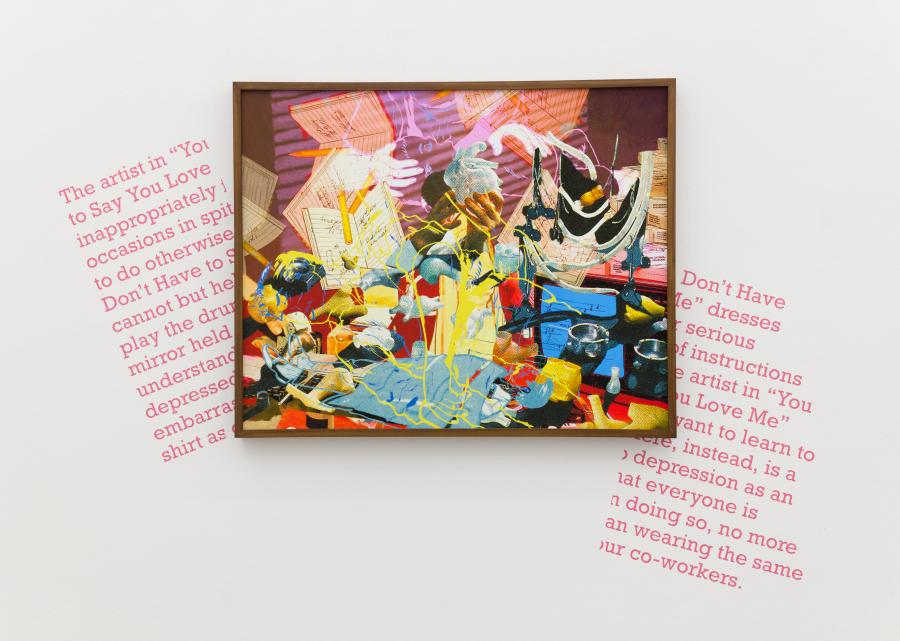Professor Jibade-Khalil Huffman: Art Beyond Boundaries
By Mia Hammett
Professor Jibade-Khalil Huffman is an accomplished multi-media artist, writer and newly appointed assistant professor of art whose interdisciplinary work runs the gamut of subject, medium and materiality. Huffman’s art draws on personal and collective histories, the aesthetic qualities of digital media and pop cultural references to challenge traditional visual and linguistic structures.
“I'm deeply resistant to the idea of, ‘I make a kind of work about this one thing’ — it really depends on the piece,” said Huffman.
Huffman’s work includes installation, performance art, digital and video collage, photography, print work, image, text and computer graphics — some of which make use of Huffman’s own archival material — whose cumulative effect is defamiliarization, deconstruction and deterioration.
After earning his B.A. from Bard College in 2003, Huffman received his M.F.A. in Literary Arts from Brown University in 2005. He later earned another M.F.A. in Studio Art from the University of Southern California’s Roski School of Fine Arts in 2013, while holding an artist-in-residence position at the Studio Museum in Harlem, New York.
Huffman’s recent exhibitions and screenings have been featured at prestigious institutions, including the Hammer Museum in Los Angeles; Fonds Régional d'Art Contemporain de Bretagne, in Brittany, France; the Museum of Modern Art in New York; the Wexner Center for the Arts in Columbus, Ohio; the Nasher Museum of Art at Duke University; the Swiss Institute in New York; the Portland Institute of Contemporary Art; MoCA in Los Angeles; Ballroom Marfa in Marfa, Texas and The Kitchen in New York. Additionally, Huffman has published three books of poetry: 19 Names for Our Band (2008), James Brown is Dead (2011) and Sleeper Hold (2015).
Rooted in his artistic and literary accomplishments, Huffman is an integral member of the Poetic Justice cluster, an interdisciplinary initiative across schools, and a cornerstone of UCI’s Black Thriving Initiative. This role highlights his dedication to supporting the extensive creative output of Black Southern Californians and to strengthening ties between UCI and community-oriented institutions committed to preserving Black history, art and culture.
On Educating and Creating
Huffman appreciates the time and resources that UC Irvine provides, allowing him to focus on his passion for education.
“I would be remiss to not speak to being an artist and having a tenure track job versus the adjunct track. I don't come from money; I come from a single parent household. I'm very forthcoming about this fact with students. As an artist, teaching is this thing that can be a supplement to your income as an artist. There’s stability, which is great. It allows me more bandwidth and headspace to be a better professor — and that's what I'm here for,” said Huffman.
When asked about his creative process, Huffman considers his work to be highly cyclical. “I’ve always said my art practice is like that of a novelist. I become focused on a particular subject and the things surrounding that. The next project might look in some ways like that initial thing — but it's also about the specifics of that new project. I think a lot of artists always come back to the same sorts of things. For me, the consistent idea is interiority, which is highly related to poetry and the novel,” said Huffman.
In considering the advantages his chosen mediums provide, Huffman generally dismisses the art-history concept of medium specificity, adopting instead his own foundational approach to artmaking. “For me, the question is, ‘what do these media provide me as a means for dealing with an idea in a varied way?’ and less about the history and context of the medium.
Huffman is consistently opposed to expectations wrought by a particular mode of creative expression — be it painting, photography, or poetry. In fact, the boundaries of medium shift in his hands: videos become poems; installations become images; images become complexly digital-physical collages.
Huffman is currently preparing for his upcoming exhibition at Anat Ebgi gallery in Los Angeles this fall. This presentation will further demonstrate his inquisitive approach to blending various art forms, pushing the boundaries of traditional media to create new, immersive experiences.

Image: Jibade-Khalil Huffman, Tuskegee, 2019.
To read more about Jibade-Khalil Huffman and his work, visit his Department of Art bio page here, or at anatebegi.com.

